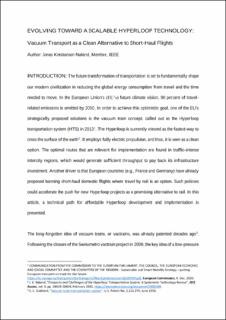| dc.contributor.author | Nøland, Jonas Kristiansen | |
| dc.date.accessioned | 2022-02-17T11:45:50Z | |
| dc.date.available | 2022-02-17T11:45:50Z | |
| dc.date.created | 2021-12-03T01:25:18Z | |
| dc.date.issued | 2021 | |
| dc.identifier.citation | IEEE Electrification Magazine. 2021, 9 (4), 55-66. | en_US |
| dc.identifier.issn | 2325-5897 | |
| dc.identifier.uri | https://hdl.handle.net/11250/2979662 | |
| dc.description.abstract | The future transformation of transportation is set to fundamentally shape our modern civilization in reducing the global energy consumption from travel and the time needed to move. In the future climate vision of the European Union (EU), 90% of travel-related emissions will be omitted by 2050. To achieve this optimistic goal, one of the EU’s strategically proposed solutions is the vacuum train (vactrain) concept, known as the hyperloop transportation system (HTS) in 2013 (European Commission 2020). The hyperloop is currently viewed as the fastest way to cross Earth’s surface (Nøland 2021). It employs fully electric propulsion and, thus, it is seen as a clean option. The optimal routes that are relevant for implementation are found in traffic-intense intercity regions, which would generate sufficient throughput to pay back its infrastructure investment. Another driver is that European countries (e.g., France and Germany) have already proposed banning short-haul domestic flights where travel by rail is an option. Such policies could accelerate the push for new hyperloop projects as a promising alternative to rail. In this article, a technical path for affordable hyperloop development and implementation is presented. | en_US |
| dc.language.iso | eng | en_US |
| dc.publisher | Institute of Electrical and Electronics Engineers (IEEE) | en_US |
| dc.relation.uri | https://ieeexplore.ieee.org/stamp/stamp.jsp?tp=&arnumber=9632838 | |
| dc.title | Evolving Toward a Scalable Hyperloop Technology: Vacuum transport as a clean alternative to short-haul flights | en_US |
| dc.type | Peer reviewed | en_US |
| dc.type | Journal article | en_US |
| dc.description.version | acceptedVersion | en_US |
| dc.rights.holder | © IEEE. Personal use of this material is permitted. Permission from IEEE must be obtained for all other uses, in any current or future media, including reprinting/republishing this material for advertising or promotional purposes, creating new collective works, for resale or redistribution to servers or lists, or reuse of any copyrighted component of this work in other works. | en_US |
| dc.source.pagenumber | 55-66 | en_US |
| dc.source.volume | 9 | en_US |
| dc.source.journal | IEEE Electrification Magazine | en_US |
| dc.source.issue | 4 | en_US |
| dc.identifier.doi | 10.1109/MELE.2021.3115542 | |
| dc.identifier.cristin | 1963910 | |
| cristin.ispublished | true | |
| cristin.fulltext | original | |
| cristin.fulltext | postprint | |
| cristin.qualitycode | 1 | |
